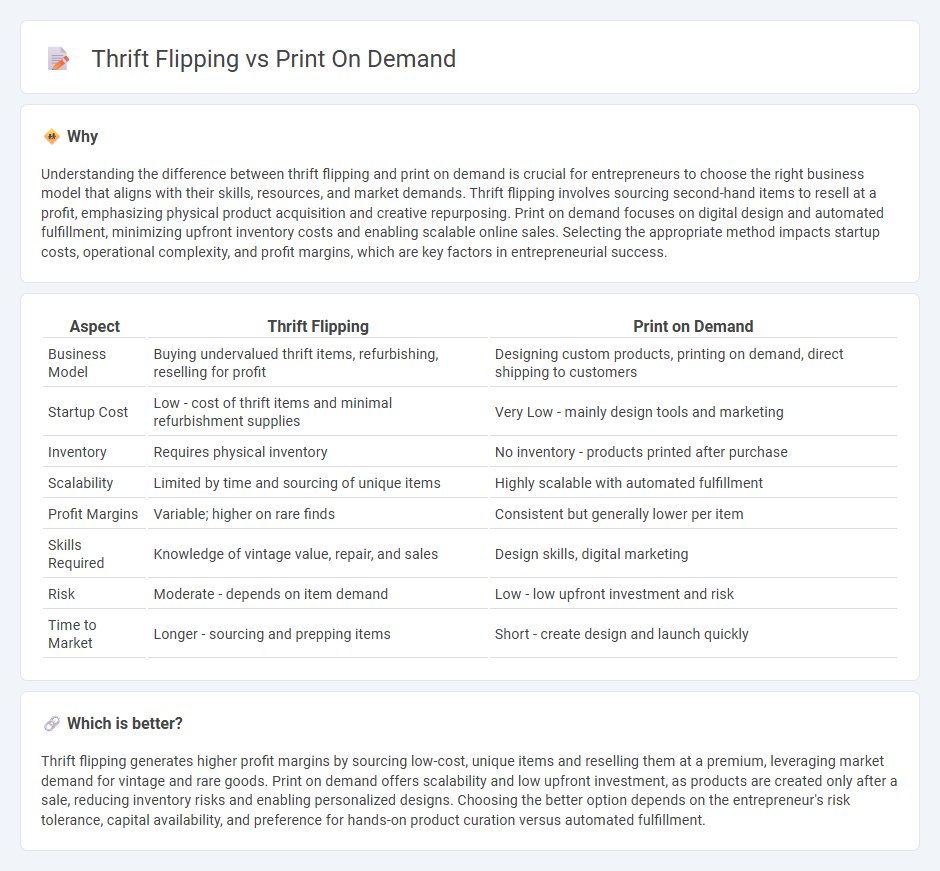
Thrift flipping involves purchasing secondhand items, refurbishing or customizing them, and reselling for profit, capitalizing on sustainable fashion trends and low initial costs. Print on demand enables entrepreneurs to create and sell customized products without maintaining inventory, reducing risk and streamlining fulfillment through automated printing and shipping. Explore these innovative business models to discover which aligns best with your entrepreneurial goals.
Why it is important
Understanding the difference between thrift flipping and print on demand is crucial for entrepreneurs to choose the right business model that aligns with their skills, resources, and market demands. Thrift flipping involves sourcing second-hand items to resell at a profit, emphasizing physical product acquisition and creative repurposing. Print on demand focuses on digital design and automated fulfillment, minimizing upfront inventory costs and enabling scalable online sales. Selecting the appropriate method impacts startup costs, operational complexity, and profit margins, which are key factors in entrepreneurial success.
Comparison Table
| Aspect | Thrift Flipping | Print on Demand |
|---|---|---|
| Business Model | Buying undervalued thrift items, refurbishing, reselling for profit | Designing custom products, printing on demand, direct shipping to customers |
| Startup Cost | Low - cost of thrift items and minimal refurbishment supplies | Very Low - mainly design tools and marketing |
| Inventory | Requires physical inventory | No inventory - products printed after purchase |
| Scalability | Limited by time and sourcing of unique items | Highly scalable with automated fulfillment |
| Profit Margins | Variable; higher on rare finds | Consistent but generally lower per item |
| Skills Required | Knowledge of vintage value, repair, and sales | Design skills, digital marketing |
| Risk | Moderate - depends on item demand | Low - low upfront investment and risk |
| Time to Market | Longer - sourcing and prepping items | Short - create design and launch quickly |
Which is better?
Thrift flipping generates higher profit margins by sourcing low-cost, unique items and reselling them at a premium, leveraging market demand for vintage and rare goods. Print on demand offers scalability and low upfront investment, as products are created only after a sale, reducing inventory risks and enabling personalized designs. Choosing the better option depends on the entrepreneur's risk tolerance, capital availability, and preference for hands-on product curation versus automated fulfillment.
Connection
Thrift flipping and print on demand both leverage low-cost resources to create unique, marketable products, enabling entrepreneurs to maximize profit margins with minimal upfront investment. Thrift flipping involves sourcing undervalued items from secondhand stores and enhancing or repurposing them, while print on demand allows customization of products such as apparel or accessories by printing designs only after a sale is made. Combining these strategies empowers entrepreneurs to scale creative businesses sustainably, reducing inventory risks and capitalizing on consumer demand for personalized, affordable goods.
Key Terms
Inventory management
Print on demand eliminates inventory management by producing products only after a customer places an order, reducing storage costs and risks of unsold stock. Thrift flipping requires careful inventory selection, storage, and quality control to ensure profitability from reselling pre-owned items. Explore effective strategies to optimize inventory management in both business models for better operational efficiency.
Product sourcing
Print on demand leverages digital technology to create customized products without holding inventory, streamlining product sourcing through partnerships with suppliers who handle printing and shipping. Thrift flipping relies on acquiring undervalued secondhand items from thrift stores, requiring careful selection and refurbishment to enhance product appeal. Explore deeper strategies to optimize sourcing for both models to maximize profitability.
Profit margin
Print on demand offers scalable profit margins due to low upfront costs and no inventory risks, with typical margins ranging from 20% to 50% depending on product pricing and customization. Thrift flipping involves purchasing undervalued secondhand items and reselling them for a markup, often achieving higher profit margins of 100% or more but requiring keen market knowledge and initial investment. Explore detailed strategies to maximize profit margins in both ventures by learning more.
Source and External Links
What Is Print on Demand and How To Start a Business - Print on demand is a business model where products are designed by the seller and produced by the supplier only after a customer places an order, allowing sellers to avoid inventory and upfront costs; the process involves creating designs, choosing products, listing them online, and having the print-on-demand company handle printing, packing, and shipping directly to customers.
Print on Demand for Individuals and Brands | Printful - Print on demand allows individuals and businesses to sell custom products with their own designs without holding inventory because products are printed, packed, and shipped only after an order is made, offering a low-risk, low-cost way to run an ecommerce store with global reach and quality assurance.
Print on Demand & DropShipping Platform | Printify - Printify offers a free, easy-to-use platform with over 1,300 products for creating and selling custom on-demand printed merchandise without upfront investment or fulfillment responsibility, suitable for creators, entrepreneurs, and brands looking to start or grow ecommerce businesses.
 dowidth.com
dowidth.com